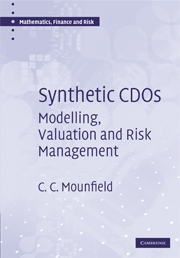Book contents
- Frontmatter
- Contents
- Preface
- Acknowledgements
- 1 A primer on collateralised debt obligations
- 2 Modelling of obligor default
- 3 Valuation of credit default swaps
- 4 Credit indices
- 5 Valuation of default baskets
- 6 Valuation of synthetic CDOs
- 7 Phenomenology of the standard market model
- 8 Risk quantification of synthetic CDOs
- 9 Implied and base correlations
- 10 Extensions of the standard market model
- 11 Exotic CDOs
- 12 Correlation trading of synthetic CDO tranches
- 13 Risk management of a portfolio of synthetic CDOs
- 14 Hedging simulation of structured credit products
- Appendix A Explanation of common notation
- Appendix B Simulated annealing
- References
- Index
13 - Risk management of a portfolio of synthetic CDOs
Published online by Cambridge University Press: 06 July 2010
- Frontmatter
- Contents
- Preface
- Acknowledgements
- 1 A primer on collateralised debt obligations
- 2 Modelling of obligor default
- 3 Valuation of credit default swaps
- 4 Credit indices
- 5 Valuation of default baskets
- 6 Valuation of synthetic CDOs
- 7 Phenomenology of the standard market model
- 8 Risk quantification of synthetic CDOs
- 9 Implied and base correlations
- 10 Extensions of the standard market model
- 11 Exotic CDOs
- 12 Correlation trading of synthetic CDO tranches
- 13 Risk management of a portfolio of synthetic CDOs
- 14 Hedging simulation of structured credit products
- Appendix A Explanation of common notation
- Appendix B Simulated annealing
- References
- Index
Summary
Introduction
In previous chapters we have analysed the valuation, calibration and risk management of synthetic CDOs as individual entities (trades). Although it is clearly of fundamental importance to understand this, in practice a financial institution (investment bank, hedge fund etc.) is not going to have just a single-tranche position on its books and will in all likelihood have many hundreds of tranches as well as many thousands of other flow instruments such as single-name CDSs and credit index positions (for both speculation and hedging purposes). All of these tranches will have different attachment/detachment points, maturities, portfolio compositions etc. and there will be a combination of long/short positions. Individual traders, portfolio managers and originators will typically only have an interest in the positions that they are actively responsible for managing on their desk and so may not be overly concerned with the overall risk picture of the entire institution. However, a risk management function will want to understand what the overall exposure of the institution is to, for example, spread or correlation movements, be able to identify concentrations of obligor risk, and understand what the impact of proposed remedial/corrective action will be upon the overall exposure.
In this chapter we will consider the aggregate behaviour of a hypothetical portfolio of CDO tranches of varying composition. Of particular interest will be the following questions.
What is the P/L profile of the portfolio under certain market scenarios (such as systemic or idiosyncratic spread widening and simultaneous collapse in base correlations).
How can the portfolio be immunised against particular market scenarios (such as the default of an obligor to which there is a particularly large exposure or a large blow-out of spreads in a particular sector or a systemic spread widening scenario as occurred during summer 2007).
[…]
- Type
- Chapter
- Information
- Synthetic CDOsModelling, Valuation and Risk Management, pp. 277 - 308Publisher: Cambridge University PressPrint publication year: 2008

